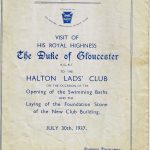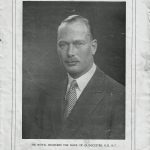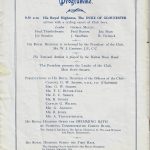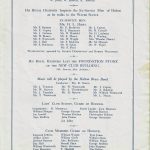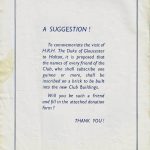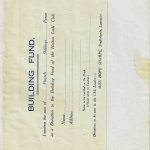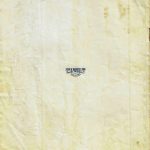Lancashire Evening Post 30 July 1937
THE DUKE OF GLOUCESTER STARTS A SWIMMING RACE
BOY WINNER ASKED: “IS IT COLD?”
A Royal Lancashire Welcome from the North of the County
CHILDREN JOIN IN WAYSIDE CHEERING
STARTING early on the second day of his whirlwind tour of Lancashire and Cheshire Boys’ Clubs, the Duke of Gloucester soon found a right Royal Lancashire welcome awaiting him.
He left Hyning at Warton, near Carnforth, where he had stayed the night with Viscount Clanfield, at 9.30, and on his journey to Halton, a village three miles from Lancaster, he was met by a cycling escort of seven members of the Halton Lads’ Club under the leadership of George Mount.
When he reached the site on which the club is to be built the Halton Brass Band struck up the National Anthem, and afterwards Mr. W. J. Garnett, High Sheriff of Lancashire, who is president of the Halton Lads’ Club, presented to the Duke, Miss Hope Sharpe, the leader of the club, who helped to start it in 1934.
The Duke learned from Miss Sharpe that a cellar in the village school had been the home of the club since it was inaugurated, and that members had now raised funds to start building new premises. He laid the foundation stone of the new building.
Started a Race
Before declaring the stone “well and truly laid,” however, he opened a swimming bath which has been made by members of the club during their leisure hours, and started the first race to be held in the baths.
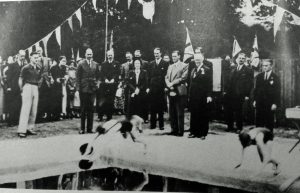
William Witham*, a 25-year-old Lancaster mill worker, who conceived the idea of the bath and made plans for it, presented to the Duke a commemorative stamp block which he himself had made. This the duke pressed into a box of soft cement, making the following impression on what will be a commemorative plaque.
“This impression was struck by H.R.H.
the Duke of Gloucester on his visit to the
Halton Lads’ Club on July 30th, 1937.”
The Duke was obviously impressed by the cordiality of his welcome. Boy Scouts and ex-Service men formed guards of honour, and territorials from the Hallamshire Battalion of the York and Lancaster Regiment lined up on one side of the swimming bath.
The Duke fired a revolver to start the first race in the baths, and the happy look in his eyes as he watched three youths – W. Jones, W. Arnold, and K. Arnold** – struggling against each other in the water was sufficient to convince everyone that he was thoroughly enjoying the race.
“Is it Cold”?
W. Arnold, a 15-year-old butcher’s apprentice at Lancaster, won, and he walked to the Duke who shook hands warmly, congratulated him on winning the first race in the new baths, and asked him: “Is it cold in there?”
As he walked away, Arnold admitted that it was cold, but said that he had told the Duke “it was not so bad.”
“I am proud to have won the first race and to have shaken hands with the Duke,” he added delightedly.
Then the Duke walked up a hill into a field where he saw two members of the club open the sluice gates they have built in the Furness (sic) Beck, a tributary of the River Lune from which the bath gets its water.
As he left to the accompaniment of deafening cheering the band struck up “For he’s a jolly good fellow.”
continues . . .
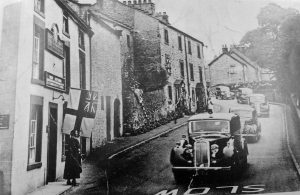
* William Whitham was born 12 Jun 1910 in Lancaster. In 1939 he is recorded as a Block Cutter Designer for Surface Printing living at 73 Halton Road, Lancaster.
** William John Arnold born 10 Jan 1922. Listed as 2nd man on lorry-petrol pool in 1939.
Kenneth Maudsley Arnold born 28 Dec 1923. A window cleaner in 1939.
Living at 80 Lancaster Road, Morecambe
Parents John Arnold, Ellen Geldart Harris- married 1919 St. Barnabas, Morecambe.
Lancaster Guardian 06 August 1937:
Duke of Gloucester Among Boys and Workpeople
A BUSY TIME AT LANCASTER AND HALTON
Surprise Visit to Cotton Mill
. . . The smiling Duke received a magnificent welcome on the first stage of his day’s programme. Leaving the residence of the Viscount Clanfield, where he had stayed the night, he took the main A6 road as far as Slyne, turning off at Halton Lane, where he was met by an advance guard of cyclists under the leadership of George Mount. They were Fred Thistlethwaite, Joe Standen, Fred Burrow, J. Sandham, Jim Shaw, and R. Dymock – all members of Halton Lads’ Club.
On arrival at the entrance to the grounds of the pool and new clubhouse the Duke was cheered to the echo by large crowds of villagers and loyal subjects from far and near who had come to Halton honouring the King’s brother.
Met by High Sheriff
H.R.H. walked between a guard of honour of Lads’ Club Scouts, and at the entrance to the baths was met by Mr. W. J. Garnett, J.P,. C.C., High Sheriff of Lancashire, who is President of the club. Halton Brass Band struck up the National Anthem, and the Duke appeared highly pleased, as he looked around him at the vast crowd of people who had assembled to welcome him.
Miss Hope Sharpe, leader of the Club, was presented to His Royal Highness, and she in turn presented officials of the Club and others.
Chatting with Miss Sharpe about the project of the new club, the Duke next passed through a guard of honour formed by members of the Club, and proceeded to a point at the head of the new bath, where he was handed a commemorative stamp block which he pressed into a soft block of cement. The impression was: “This impression was struck by H.R.H. Duke of Gloucester on his visit to the Halton Lads’ Club, July 30th, 1937.” The stamp was handed to the Duke by George Witham, a 25-year-old Mill employee, who had made the die and who had also conceived the idea of the bath and made the plans.
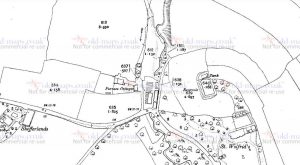
The Bath Opened
The box containing the plaque was sealed, but before it was taken away the Duke was shown an impression on paper. He appeared most interested and asked George several questions about it.
The ceremony over the Duke moved over to a corner of the open-air bath, where he was handed a pistol by George Addison, jun., with which to start the first swimming race. This was between W. Jones, W. Arnold, and K. Arnold.
When the lads dived in the Duke’s face lit up with keen interest, and he followed the progress of the hard-fought race with the closest possible attention. When W. Arnold won the Duke went up to him and congratulated him.
He asked him if the water was cold and the winner, who is a 15-year-old butcher’s apprentice, said it that it was “not so bad.”
To a reporter afterwards he said: “I am proud to have won the first race and to have shaken hands with the Duke.”
It was noticed that the boy’s hands were still dripping with water when the Duke exchanged the hand-shake with him.
He admitted that the water was rather cold, and said that the Duke said to him, “I would not mind having a dip myself.”
The Duke then walked up a hill between the ranks of Halton ex-Service men, whom he inspected, and proceeded to a field, where George Dorrington and Robert Wilkinson operated the sluice gates in Furness (sic) Beck, a Lune tributary from which the bath gets its water supply.
The Duke evinced the greatest possible interest in the sluice and asked questions about it, being pleased to know that it had been constructed by the lads themselves.
Foundation Stone Laying
Returning to the bath the Duke laid the foundation stone of the new club-house, declaring the stone “well and truly laid.”
More presentations were made to H.R.H. and to the accompaniment of deafening cheers and the strains of “For he’s a jolly good fellow,” the Duke returned to the car and moved off to Lancaster.
(continues) but image is poor and text unreadable
The Halton Club Scouts guard of honour was composed of the following: Mr. R. Marshall (Scoutmaster), Jack Morgan (patrol leader), W. Morgan (Shefferland Cottages), J. Arnold, A. Redfern, G. Fawcett, T. Kitchen, J. Daines, J. Jolley, H. Burrow, C. Dobson, S. Stevenson.
The club guard of honour was formed by Corpl Jeffries, Arthur Jones, H. Bateson, J. Hill, W. Westworth, E. Rogerson, W. Wright, W. Croft, A. Robinson, R. Slack, H. Stevenson, T. Hosfield, T. Jones, W. Noon, W. Nixon, G. Redfern, J. Simpson, and A. Bolton.
At Halton the Duke was presented with a silver commemorative trowel and at Lancaster with a mallet made of Empire wood.
In an exclusive interview with a “Guardian” reporter after the ceremony, Miss Sharpe stated that the Duke had expressed considerable satisfaction at the excellence of the project. He thought it was a fine example of a village Lads’ Club and congratulated all the leaders on the fine work they were doing.
Lancaster Guardian 23 July 1937:
Next week’s royal visit.
Lower Lunesdale folk are excited at the prospect of a royal visit to Halton on Friday next, when HRH the Duke of Gloucester will open an open air swimming bath and lay the foundation stone of a new building for the local lads club.
(continues)
Halton Lads Club was founded by Miss Hope Sharpe, daughter of Colonel and Mrs G. W. Sharpe, of Shefferlands, Halton, just after the visit of the Duke of Gloucester to Lancaster to inaugurate the Lancashire and Cheshire Association. Work went on quietly for a long time and Miss Sharpe organised various efforts to raise funds for premises. She founded an amateur theatrical company known as ‘The Players’. and in the productions at Lancaster of Berkeley Square, the Trial of Mary Dugan and the Barretts of Wimpole Street, substantial sums were raised.
As the existence of the club became more generally known, further help was soon forthcoming and when Mr. T C Butler-Cole, of Beaumont Cote offered a derelict fish hatchery as a site for a bathing pool and headquarters of the club enthusiasm on the part of Miss Sharpe and the members of the club knew no bounds.
VOLUNTARY HELPERS
A tremendous amount of voluntary work has been put in at Halton, and there is yet much to do. The site, which was originally an iron furnace, owned by the Bradshaw family, who owned Halton Hall, has had to be cleared of trees and thick undergrowth, and the concrete foundations of the bath, which were used in connection with the furnace and fish hatchery, have had to be cleared of debris and scraped.
Alterations and additions have had to be made and broken concrete has had to be repaired. When the Duke opens the bath by starting a swimming race with a pistol, it will present a smart appearance with its white sides and bottom.
